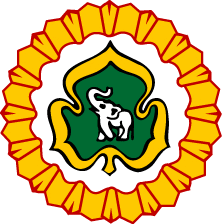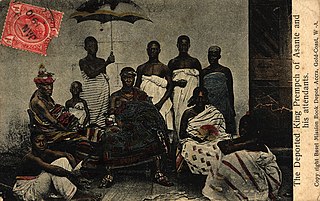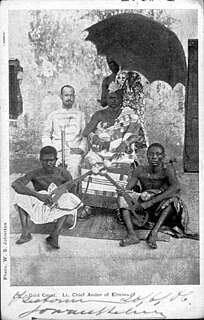
Scouting, also known as the Scout Movement, is a worldwide youth movement employing the Scout method, a program of informal education with an emphasis on practical outdoor activities, including camping, woodcraft, aquatics, hiking, backpacking, and sports. Another widely recognized movement characteristic is the Scout uniform, by intent hiding all differences of social standing in a country and making for equality, with neckerchief and campaign hat or comparable headwear. Distinctive uniform insignia include the fleur-de-lis and the trefoil, as well as merit badges and other patches.

Lieutenant-General Robert Stephenson Smyth Baden-Powell, 1st Baron Baden-Powell, was a British Army officer, writer, founder and first Chief Scout of the world-wide Scout Movement, and founder, with his sister Agnes, of the world-wide Girl Guide / Girl Scout Movement. Baden-Powell authored the first editions of the seminal work Scouting for Boys, which was an inspiration for the Scout Movement.

Olave St Clair Baden-Powell, Baroness Baden-Powell was the first Chief Guide for Britain and the wife of Robert Baden-Powell, 1st Baron Baden-Powell, the founder of Scouting and co-founder of Girl Guides. She outlived her husband, who was 32 years her senior, by over 35 years.

The 4th World Scout Jamboree, a gathering of Boy Scouts from all over the world, was hosted by Hungary and held from 2 to 13 August 1933. It was attended by 25,792 Scouts, representing 46 different nations and additional territories. They encamped around the Royal Palace in the Royal Forest of Gödöllő, about 11 miles from the capital of Budapest.

Cub Scouts, Cubs or Wolf Cubs are programs associated with Scouting for young children usually between 7 and 12, depending on the organization to which they belong. A participant in the program is called a Cub. A group of Cubs is called a 'Pack'.

Agnes Smyth Baden-Powell was the younger sister of Robert Baden-Powell, 1st Baron Baden-Powell, and was most noted for her work in establishing the Girl Guide movement as a female counterpart to her older brother's Scouting Movement.

The Scout Motto of the Scout movement, in various languages, has been used by millions of Scouts around the world since 1907. Most of the member organizations of the World Association of Girl Guides and Girl Scouts (WAGGGS) share this same motto.

The three-finger salute is used by members of Scout and Guide organizations around the world when greeting other Scouts and in respect of a national flag at ceremonies. In most situations, the salute is made with the right hand, palm face out, the thumb holding down the little finger, and with the fingertips on the brow of the head. There are some variations of the salute between national Scouting organizations and also within some programme sections.

The Bharat Scouts and Guides (BSG) is the national Scouting and Guiding association of India. The national headquarters of BSG is recognised by the Government of India.
Beavers is a program associated with some Scouting organizations generally for children aged 6 to 8 who are too young for the Cub program.

The Anglo-Ashanti wars were a series of five conflicts that took place between 1824 and 1900 between the Ashanti Empire—in the Akan interior of the Gold Coast—and the British Empire and its African allies. Though the Ashanti emerged victorious in some of these conflicts, the British ultimately prevailed in the fourth and fifth conflicts, resulting in the complete annexation of the Ashanti Empire by 1900. The wars were mainly due to Ashanti attempts to establish a stronghold over the coastal areas of present-day Ghana. Coastal peoples such as the Fante and the Ga came to rely on British protection against Ashanti incursions.

The 3rd World Scout Jamboree was held in 1929 at Arrowe Park in Upton, near Birkenhead, Wirral, United Kingdom. As it was commemorating the 21st birthday of Scouting for Boys and the Scouting movement, it is also known as the Coming of Age Jamboree. With about 30,000 Scouts and over 300,000 visitors attending, this jamboree was the largest jamboree so far.

The Sri Lanka Girl Guides Association is the national Guiding organization of Sri Lanka. It serves 54,824 members. Founded in 1917, the girls-only organization became a full member of the World Association of Girl Guides and Girl Scouts in 1951.
The Scout and Guide movement in Malta is served by three organizations:

Prempeh I was the thirteenth king ruler of the Ashanti Empire and the Oyoko Abohyen Dynasty. King Prempeh I ruled from March 26, 1888 until his death in 1931, and fought an Ashanti war against Britain in 1893.

The graves of Lieutenant-General The 1st Baron Baden-Powell and his wife, Olave, Baroness Baden-Powell, G.B.E., are in Nyeri, Nyeri County, Kenya, near Mount Kenya. Lord Baden-Powell died on 8 January 1941, and is buried in St. Peter's Cemetery in the Wajee Nature Park. When his wife Olave, Lady Baden-Powell, died, her ashes were sent to Kenya and interred beside her husband. Kenya has declared Baden-Powell's grave a national monument, Scouters consider the grave, "one of the most revered shrines and pilgrimage sites in the world."

Girl Guides is a movement found worldwide, which was originally and still largely designed for girls and women only. The movement began in 1909 because girls demanded to take part in the then grassroots Boy Scout Movement.

Chief Kweku Andoh was a military officer in the British army and Regent of Edina State (1873–1898). The Fanti expression "Andoh nye woa?" meaning "Art thou Andoh?" is a way of saying "Who Do You Think You Are?" and serves as a testament to the great esteem held towards Chief Andoh.

The Grand Howl is a ceremony used by Cub Scouts and Brownies. It was devised by Robert Baden-Powell, the author of the scouting guide Scouting for Boys, and is based on the Mowgli stories in Rudyard Kipling's Jungle Book. In the ceremony, Cubs act out the wolves greeting Akela, the "Old Wolf", at the Council Rock and are reminded of the Cub Scout Promise. Baden-Powell also created a Grand Howl for Brownie Guides, which was in imitation of an owl instead of a wolf. It has been used as an opening and closing ceremony as well as a method of conveying thanks or appreciation by all sections of Scouting.

















